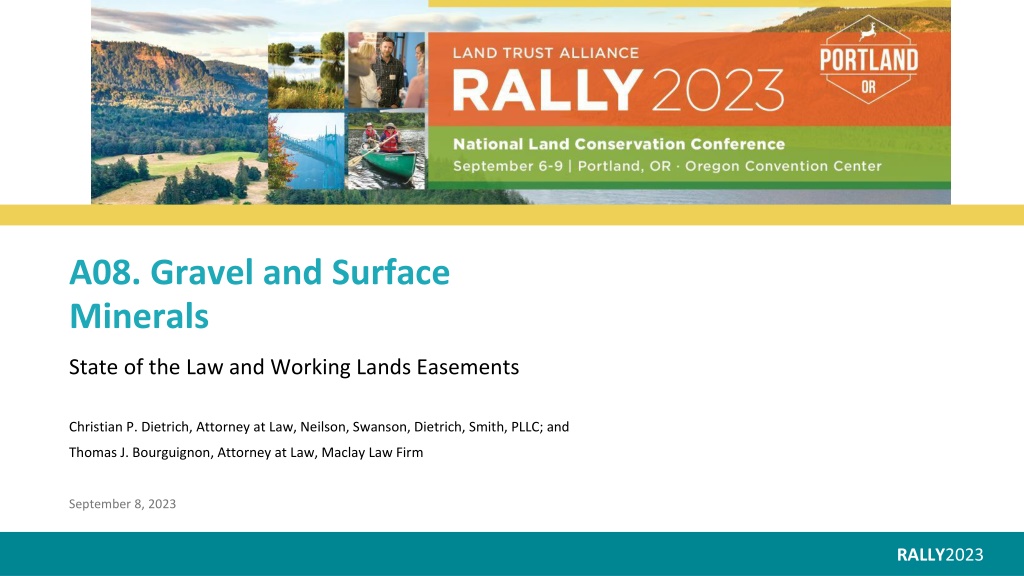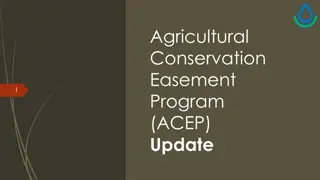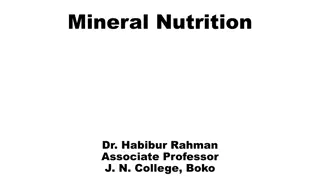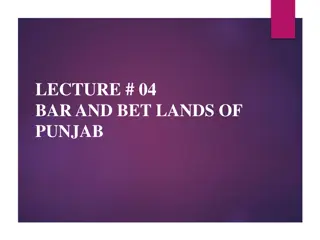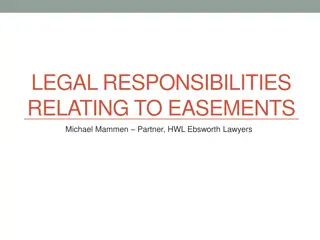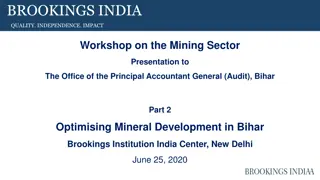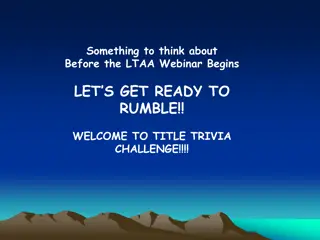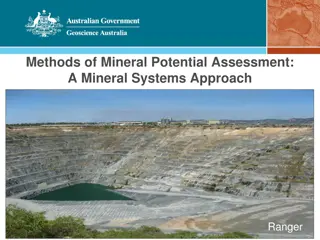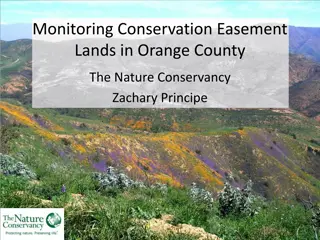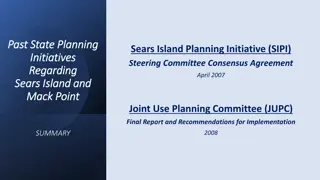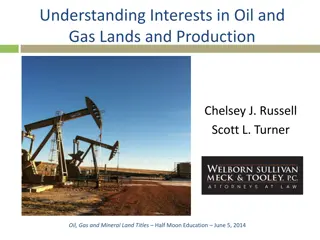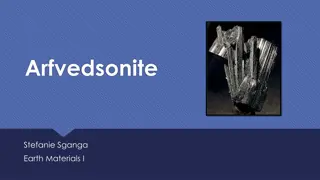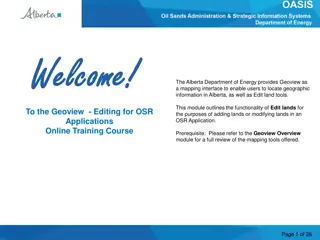Understanding Mineral Rights and Conservation Easements in Working Lands
The presentation explores the complex laws governing mineral rights and conservation easements, focusing on tax deductibility, case law, and practical applications for allowing limited gravel extraction. It delves into the basics of mineral estates, the proverbial "bundle of sticks" concept, and how mineral rights can be severed from surface estates. Despite the complexity, the aim is to provide a foundational understanding for land trusts and professionals involved in mineral extraction on donated lands.
Download Presentation

Please find below an Image/Link to download the presentation.
The content on the website is provided AS IS for your information and personal use only. It may not be sold, licensed, or shared on other websites without obtaining consent from the author. Download presentation by click this link. If you encounter any issues during the download, it is possible that the publisher has removed the file from their server.
E N D
Presentation Transcript
A08. Gravel and Surface Minerals State of the Law and Working Lands Easements Christian P. Dietrich, Attorney at Law, Neilson, Swanson, Dietrich, Smith, PLLC; and Thomas J. Bourguignon, Attorney at Law, Maclay Law Firm September 8, 2023 RALLY2023
2 Outline of Presentation I. II. Review of legal authorities regarding tax deductibility of conservation easements with reserved Basics severed mineral estates; what are minerals ; relevant state and federal laws mineral rights A. Provisions from the tax code and IRS regs B. Review of case law on mineral rights and recent IRS Chief Counsel Memorandum C. Conservation purposes, pre-existing uses, and other wrinkles III. Practical applications: can working lands conservation easements still allow for limited and localized gravel extraction? A. Historic approaches to limited sand and gravel reservations B. New approaches responsive to the case law and Chief Counsel Memorandum C. Considering paths forward in the face of uncertainty RALLY2023
3 Overall Goals and Disclaimer The law(s) affecting mineral extraction and mineral rights are highly complex. How laws are applied to minerals can be contradictory, and can vary widely in different states. Very much dependent on fact and context This presentation aims to provide some basic information about minerals and mineral rights in general, and about mineral extraction in donated Conservation Easements under Section 170 of the tax code. We could talk about this for days, and can only give a brief overview. Land trusts and other professionals are advised to seek legal counsel to review specific details related to a project. RALLY2023
4 I. The Basics A. The so-called bundle of sticks and severed (or intact) mineral estates B. What even are minerals ? C. Short summary of state and federal statutes and caselaw regarding minerals and gravel generally RALLY2023
5 The Proverbial Bundle of Sticks If a property owner owns all interests in a property, they own the entire bundle of sticks : RALLY2023
6 The Proverbial Bundle of Sticks Each stick in the bundle of sticks can be conveyed and held separately: RALLY2023
7 Surface Estate and Mineral Estate Mineral estate can be severed (in different ownership) from the surface estate Once severed, conveyances by the surface estate owner won t affect the mineral estate Mineral rights often severed: When a property owner conveys the surface and reserves mineral rights; or When United States patents land to private person, but reserves mineral rights. RALLY2023
8 What are minerals ? Various laws answer that question in different ways Federal laws (e.g. homestead laws, General Mining Act; Endangered Species Act; Surface Mining Control and Reclamation Act; Clean Water Act; etc.) State laws (e.g. property law concepts of ownership, state permitting regimes for mineral extraction and reclamation) Local laws (e.g. zoning ordinances that affect land use) RALLY2023
9 What are minerals ? From an Idaho court: [M]ineral has not been defined by Idaho case law. Moreover it has no recognized legal meaning. Ida-Therm, LLC v. Bedrock Geothermal, LLC, 293 P.3d 630 (Id. 2012)(emphasis added). RALLY2023
10 Minerals, defined (1) Oxford English Dictionary definition(s) of mineral : 2.a. A naturally occurring substance of neither animal nor vegetable origin; an inorganic substance. (Not now in technical use.) 2.b. A substance obtained by mining; a product of the depths of the earth, esp. one other than a native metal. Also in Mining: an ore. Also figurative. In some modern contexts not distinguishable from sense 2.c. 2.c. Science. A solid, naturally occurring, usually inorganic substance with a definite chemical composition and characteristic physical structure and properties (such as crystalline form). Oxford University Press. (2023, July). Mineral, n. In Oxford English Dictionary. Retrieved August 29, 2023. RALLY2023
11 Minerals, defined (2) From Black s Law Dictionary: 1. Any natural inorganic matter that has a definite chemical composition and specific physical properties that give it value <most minerals are crystalline solids>. 2. A subsurface material that is explored for, mined, and exploited for its useful properties and commercial value. 3. Any natural material that is defined as a mineral by statute or caselaw. Mineral, Black s Law Dictionary (10th ed. 2014). RALLY2023
12 Minerals, defined (3) Within the law of any one state, mineral is often defined in different, contradictory ways. (1) The term mineral, . . . as used in this chapter . . . shall be construed to mean and include all coal, oil, oil shale, gas, phosphate, sodium, asbestos, gold, silver, lead, zinc, copper, antimony, geothermal resources, salable minerals, and all other mineral lands, minerals or deposits of minerals[.] [S]alable minerals means a mineral substance that can be taken from the earth and that has a value . . . apart from the earth and includes, but is not limited to, building stone, cinders, pumice, scoria, clay, diatomaceous earth, sand, gravel, quartz, limestone and marble. I.C. 47-701(1) and 47-701A. Idaho Mined Land Reclamation Act: Mineral means coal, clay, stone, sand, gravel, metalliferous and nonmetalliferous type of ores, and any other similar solid material or substance of commercial value to be excavated from natural deposits on or in the earth. I.C. 47-1503(6). RALLY2023
13 Minerals in state case law E.g. is limestone a mineral ? Heinatz v. Allen Emilie Heinatz leaves 400 acres of land to her daughter, exclusive of mineral rights ; and conveys the mineral rights to other heirs. Surface owner quarries and sells limestone; mineral right owners sue. Using an ordinary-language interpretation of the Will, and following many prior authorities, Texas Supreme Court concludes that limestone is part of the surface estate. The words the mineral rights in the will are interpreted according to their ordinary and natural meaning unless there is a clear indication that it was intended to have a [different meaning]. [S]ubstances such as sand, gravel and limestone are not minerals within the ordinary meaning... unless they are rare and exceptional or possess special value. Heinatz v. Allen, 147 Tex. 512 (1949). RALLY2023
14 Minerals in state case law (2) Are dinosaur bones a mineral ? Murray v. BEJ Minerals Surface owner, Murray, finds highly valuable dueling dinosaur bones, and other dinosaur bones, valued at around $10-20 million. Mineral rights owner sues, arguing dinosaur bones are a mineral. Federal district court: Surface owner wins; dinosaur bones are not minerals; applies Heinatz ordinary and natural test. 9thCircuit: Mineral right owner wins; these dinosaur bones are rare and exceptional in character. (2-1; dissenting opinion) Montana Supreme Court (certified question): Surface owner wins; dinosaur bones are not minerals. Examines specific language in mineral deed; also concludes fossils and minerals are treated differently under the law. (4-3; dissenting opinion) Murray v. BEJ Minerals, LLC, 400 Mont. 135 (2020). RALLY2023
15 Minerals in state case law Language in the conveyance document is key In cases such as Heinatz, courts routinely review the language of the conveyance deed. Not just the relevant sentence/phrase, but the entire instrument as a whole. Court s goal is to identify the intent of the grantor. If conveyance instrument is found to be ambiguous, court might accept other evidence. RALLY2023
16 Minerals in federal statutes and case law Language in the statute is often key Federal courts routinely review the language of the statute (or regulation). Court will carefully read not just the relevant phrase but the statute as a whole. Court s goal is often to identify the intent of Congress. If statute is found to be ambiguous, court might look at other evidence of legislative intent. RALLY2023
17 Early federal statutes Homestead Act of 1862: Doesn t mention minerals. Early patents issued to homesteaders include all minerals. Act of May 20, 1862, PL 37-64, ch. 75, 12 Stat. 392. Act in 1864 creating the Northern Pacific Railroad: Railroad gets grants of lands; all mineral lands [are] hereby excluded from the act the word mineral shall not be held to include iron or coal. Act granting lands to the new State of Nevada, some minerals are reserved to the US: In all cases lands valuable for mines of gold, silver, quicksilver, or copper shall be reserved from sale[.] Act dated July 4, 1866, concerning Lands granted to the State of Nevada, ch. 166, 14 Stat. 86 (codified in 30 U.S.C. 21) RALLY2023
18 Early Federal statutes (2) General Mining Act of 1872 Sec. 1: all valuable mineral deposits [on federal land] are hereby declared to be free and open to exploration and purchase . . . by citizens of the United States . . . and according to the local customs or rules of miners[.] Sec. 2: mining-claims upon veins or lodes of quartz or other rock in place bearing gold, silver, cinnabar, lead, tin, copper, or other valuable deposits . . . shall be governed as to length along the vein[.] Minerals are not more specifically defined in the 1872 Act. Mineral surveys were conducted pursuant to the 1872 Act, identifying mineral lands. General Mining Act of May 10, 1872, ch. 152, 17 Stat. 91 (codified as amended at 30 U.S.C. 21-54). RALLY2023
19 Is gravel a mineral under the Homestead Acts? Zimmerman v. Brunson Brunson is homesteader on dry land near Conrad, Montana. Zimmerman, mineral rights holder, demands that homestead patent be canceled because land, which has gravel, should be classified as mineral lands. In 1910, Department of Interior (DOI) hears administrative challenge whether gravel was included in homestead patent to Brunson. DOI concludes that gravel is not a mineral ; no previous cases had concluded that surface gravel might be a mineral. Gravel deposits, unless they possess a peculiar property . . . giving them a special value, are not mineral. [note: same language as Heinatz uses in 1949] Brunson s homestead entry remains in place, and Brunson can extract the gravel. Zimmerman v. Brunson, 39 I.D. 310 (1910)(later overruled by Layman v. Ellis, 52 I.D. 714 (1929). RALLY2023
20 Early Federal statutes (3) Stock Raising Homestead Act of 1916 (SRHA) In 1916, Congress passes the SRHA that, among other things, includes a reservation to the US of all minerals beneath lands patented out to homesteaders. Section 9. all entries made and patents issued under the provisions of this Act shall be subject to and contain a reservation to the United States of all the coal and other minerals in the lands so entered and patented, together with the right to prospect for, mine, and remove the same. Stock Raising Homestead Act (SRHA) of December 29, 1916, ch. 9, 39 Stat. 862 (codified at 43 U.S.C. 291); later suspended by The Taylor Grazing Act of 1934, ch. 865, 48 Stat. 1269 (codified at 43 U.S.C. 310 et seq); repealed by the Federal Land Policy and Management Act of 1976, PL 94-579, 702, 90 Stat. 2787 (codified at 43 U.S.C. 1701). RALLY2023
21 Is gravel a mineral under the SRHA? Watt v. Western Nuclear, Inc., 462 U.S. 36 (1983) US Supreme Court considers whether, in patents issued pursuant to the SRHA of 1916, gravel was one of the minerals reserved to the US by Section 9 of the SRHA, which reserved all the coal and other minerals to the US. Court holds, 5-4, that: Gravel is a mineral reserved by the US in the SRHA. Court reasons that Congress passed the SRHA to promote concurrent development of the surface estate (with grazing) and the mineral estate (by reserving minerals and patenting them separately). Court says Congress intended the mineral reservation to include substances that are inorganic, that can be removed from the soil, that can be used for commercial purposes, and that [were not clearly intended] to be included in the surface estate. RALLY2023
22 Different results in state and federal cases State cases Gravel typically (not always) treated as part Federal cases Treatment of gravel depends on which of the surface estate Analyze intent in conveyance document(s) federal statute Congress s intent regarding the statute Treatment of gravel has evolved over time Separate value analysis RALLY2023
23 II. Statutes and Regs from the Conservation Easement context RALLY2023
24 Review of available legal authorities: statutory and regulatory provisions from federal CE tax law Roadmap: (4) Conservation purpose defined. (A) the term conservation purpose means IRC 170(h)(5)-(6) T.R. 1.170A-14(e)(3) (iii) the preservation of open space (including T.R. 1.170A-14(f) farmland and forest land) where such preservation is-- T.R. 1.170A-14(g)(4) (I) for the scenic enjoyment of the general public, or T.R. 1.170A-14(h)(5) (II) pursuant to a clearly delineated Federal, State, or local governmental conservation policy. RALLY2023
25 Review of available legal authorities: IRC 170(h)(5)-(6) 170(h)(5) (B) No surface mining permitted.-- 170(h)(6) (i) In general.--Except as provided in clause (ii), in the case of a contribution of any interest where there is a retention of a qualified mineral interest, subparagraph (A) (the perpetuity requirement) shall not be treated as met if at any time there may be extraction or removal of minerals by any surface mining method. (6) Qualified mineral interest.--For purposes of this subsection, the term qualified mineral interest means-- (A) subsurface oil, gas, or other minerals, and (B) the right to access to such minerals. (ii) Special rule.--With respect to any contribution of property in which the ownership of the surface estate and mineral interests has been and remains separated, subparagraph (A) shall be treated as met if the probability of surface mining occurring on such property is so remote as to be negligible. RALLY2023
26 Review of available legal authorities: IRC 170(h)(5)-(6) history 1980: Permanent conservation easement 1986: Final Treasury regulations issued. federal tax incentives are enacted and Section 1.170A-14(g)(4)(ii) reflects state codified into IRC 170(h). of the law after 1984 amendment to 170(h). 1984: IRC 170(h)(5)(B)(ii) is added via amendment, providing for so remote as 1997: So remote as to be negligible to be negligible standard so long as the standard applies to all properties separation of the mineral estate was (current law). after 1976 (and other requirements). RALLY2023
27 Review of available legal authorities: T.R. 1.170A-14(e)(3) (3) Inconsistent use permitted. A use that is destructive of conservation interests will be permitted only if such use is necessary for the protection of the conservation interests that are the subject of the contribution. For example, a deduction for the donation of an easement to preserve an archaeological site that is listed on the National Register of Historic Places will not be disallowed if site excavation consistent with sound archaeological practices may impair a scenic view of which the land is a part. A donor may continue a pre-existing use of the property that does not conflict with the conservation purposes of the gift. Do either of these sentences apply to small on-property gravel sources? Is conservation of agricultural land a conservation interest ? RALLY2023
28 Review of available legal authorities: T.R. 1.170A-14(f) (f) Examples. The provisions of this section K desires to preserve his farm for relating to conservation purposes may be agricultural purposes in perpetuity. illustrated by the following examples. K grants to a qualified organization an agricultural preservation restriction on his Example 5. State S enacts program for purchase of CE s property in the form of a conservation easement. in order to protect State S's declining open K reserves right to manage the farm space that is suited for agricultural use , with consistent with sound agricultural and agricultural preservation restrictions including management practices. removal of mineral substances in any manner that adversely affects the land s agricultural potential. RALLY2023
29 Review of available legal authorities: T.R. 1.170A-14(f) (f) Examples. Example 5 (con t). The preservation of K's land is Fairly explicit endorsement of preserving open space available for agricultural use as the type of governmental conservation pursuant to a clearly delineated policy which is a qualifying conservation governmental policy of preserving open purpose under IRC 170(h)(4)(A)(iii)(II). space available for agricultural use, and Even without actual participation in the will yield a significant public benefit by government program, although area is preserving open space against designated as worthy of protection. increasing development pressures. Contemplated mineral restrictions are based on impact on agricultural purposes. How about scenic open space? RALLY2023
30 Review of available legal authorities: T.R. 1.170A-14(g)(4) (g) Enforceable in perpetuity no deduction shall be allowed when there is However, a deduction under this section will a retention of a qualified mineral interest not be denied in the case of certain methods of if at any time there may be extractions or mining that may have limited, localized impact removal of minerals by any surface mining on the real property but that are not method. irremediably destructive of significant conservation interests . RALLY2023
31 Review of available legal authorities: T.R. 1.170A-14(h)(5) (5) Protection of conservation purpose where Such documentation may include: taxpayer reserves certain rights (i) (B) A map of the area drawn to scale showing Documentation. all existing man-made improvements or for a deduction to be allowable under this incursions (such as roads, buildings, fences, or gravel pits) land use history (including section the donor must make available to the present uses and recent past disturbances) . donee, prior to the time the donation is made, documentation sufficient to establish the condition of the property at the time of the gift. (Baseline requirement.) RALLY2023
32 Review of available legal authorities: Case law and IRS CCM Roadmap: Great Northern Nekoosa v. U.S. (Ct. Fed. Cl. 1997) IRS Chief Counsel Advice Memorandum No. 202236010 (Sept. 27, 2021) Cattail Holdings, LLC v. Comm r (T.C. Memo 2023-17) (Feb. 14, 2023) JL Minerals, LLC v. Comm r, Order (Feb. 15, 2023) (USTC Dkt. No. 17076-21) North Donald LA Prop., LLC v. Comm r, T.C. Memo 2023-50 (Apr. 18, 2023) Ranch Springs, LLC v. Comm r, Order (Aug. 9, 2023) (TC Dkt. 11794-21) JL Minerals: Lessons from IRS SJ Briefing (July 31, 2023) RALLY2023
33 Legal authorities case law: Great Northern Nekoosa v. U.S. (Ct. Fed. Cl. 1997) Income tax refund action in federal court of claims GNN sought a $19M tax refund seven years after filing 1981 taxes 8,000 acres under two CEs with State of Maine. Gravel could be (and was) extracted for road and utility construction even limited- duration Resource Protection Plan allowed for expansive gravel extraction rights During lengthy proceedings, GNN eventually conceded the gravel pits were surface mining and that sand and gravel were minerals within the meaning of 170(h)(5) Case turns on rejection of GNN s argument that the surface mining prohibition did not even apply because there was no retention of a qualified mineral interest (defined in 170(h)(6) as subsurface oil, gas, or other minerals ) Case also rejects argument made by GNN of its surface mining being permitted under the limited, localized not irremediably destructive language in the Treasury Regulations Interpreting prior iterations of relevant law, but remains the seminal case in the area. RALLY2023
34 Legal authorities IRS Chief Counsel Advice Memorandum No. 202236010 (Sept. 27, 2021) Q: Is a CE deductible if: the donor of the easement retains a qualified mineral interest, the ownership of the surface estate and mineral interest has never been separated, and under the terms of the deed the donor can use a surface-mining method to extract the subsurface minerals with the donee s approval? A: No. Surface mining is not a mining method that is allowable if limited, localized and not irremediably destructive standards are met (citing Great Northern Nekoosa). Not technically applicable to CE donations using remoteness exception for severed mineral rights, but the remoteness test would hardly seem to be a valid defense for a CE deed allowing surface mining. RALLY2023
35 Legal authorities case law: Cattail Holdings, LLC v. Comm r T.C. Memo 2023-17 (Feb. 14, 2023) CE (Virginia). $40M claimed, IRS argued $3M. Some common limiting language on reserved rights (consistency with CPs, notice and approval required). No express reserved right to engage in any surface or subsurface mining activity. Syndicated 2017 Foothills Land Conservancy The exploration for, or development and extraction of, minerals and hydrocarbons by any surface or subsurface mining method, by drilling, or by any other method, or transportation of the same via new pipelines or similar facilities, that would impair or interfere with the Conservation Purposes and Conservation Values of the Property in any material respect in the discretion of the Grantee. mineral activity but allowing transportation of minerals across/under the property with approval of land trust. At issue: a confusing paragraph prohibiting allow mineral activity, with seeming exception for activities approved by land trust. Court rejected this theory on IRS SJ motion. IRS argued effect of this paragraph was to RALLY2023
36 Legal authorities case law: JL Minerals, LLC v. Comm r Order (Feb. 15, 2023) (USTC Dkt. No. 17076-21) This Order rejected an IRS motion for summary judgment on the issue of surface mining on the eve of a February 2023 trial, expressly contemplating the issue being further addressed at trial and in post-trial briefing. Right at issue: to have borrow pits, not to exceed a total of 1 acre, to provide required fill material for use, such as repairing roads, solely and exclusively on the Property. Court notes surface mining, extraction, removal are undefined in statute or regs. The trial was held and post-trial briefing is underway. Court states it cannot, on SJ, decide whether a one-acre borrow pit would be Syndicated CE based on supposed suitability for kaolin mineral development. Claimed 2017 CE value of $260k/acre despite 2015 fee purchase price of $2500/acre. treated as a surface mining method, or whether it would potentially qualify for limited localized exception. RALLY2023
37 Legal authorities case law: North Donald LA Prop., LLC v. Comm r, T.C. Memo 2023-50 (Apr. 18, 2023) Syndicated CE to Atlantic Coast IRS argued that the prior owner s mineral Conservancy. Claimed 2017 CE value of right reservation ( 75% of all oil, gas, or $471k/acre ($115M+ total) despite fee other minerals of any kind or character purchase of $3,000/acre in 2016. whatsoever ) allowed subsurface clay to be mined on the property. Appraiser Clark was sued and lost license in separate federal DOJ proceeding. Numerous reasons IRS argument failed prior deeds expressly addressed the issue. CE itself contained no problematic terms relating to mining surface or subsurface Case is yet another instance of IRS minerals. attempting to weaponize the issue of mineral activity. RALLY2023
38 Legal authorities case law: Ranch Springs, LLC v. Comm r Order (Aug. 9, 2023) (TC Dkt. 11794-21) Order is an all but verbatim copy of the order rejecting IRS SJ before trial in the JL Minerals case. Same CE language at issue. Case is set to go to trial in December 2023. How many minerals cases are in the pipeline? RALLY2023
39 Legal authorities case law: JL Minerals, LLC v. Comm r Lessons from IRS SJ Briefing (July 31, 2023) IRS noting there is no limit on number of Borrow pits = surface mining prohibited by gravel pits (at any one time, or, ever). 170(h)(5)(B): Similarly, with a borrow pit, a cut is made into the earth where the IRS stating outright that sand and gravel topsoil is removed and the sand and gravel are extracted using surface mining is excavated for use. methods. Citing Great Northern repeatedly. No apparent room in IRS argument for application of limited localized , or for any impact on analysis due to restrictions on size, number, or required uses of material. RALLY2023
40 What is (and isn t) a surface mining method per 170(h)(5)(B)? Often considered surface mining : Strip mining Open-pit mining Mountain-top removal Placer mining Some underground mines Some in-situ mining Some dredging Often considered not surface mining: Some underground mines Directional drilling from wells on other properties Unitization through unit wells located on other lands (from North Donald) RALLY2023
41 Pre-existing uses and T.R. 1.170A-14(e)(3) 1.170A-14(e): a donation must be exclusively for conservation purposes. 1.170A-14(e)(3): Inconsistent use permitted. A use that is destructive of conservation purposes will be permitted only if such use is necessary for the protection of the conservation interests that are the subject of the contribution. For example, a deduction for the donation of an easement to preserve an archaeological site that is listed on the National Register of Historic Places will not be disallowed if site excavation consistent with sound archaeological practices may impair a scenic view of which the land is a part. A donor may continue a pre-existing use of the property that does not conflict with the conservation purposes of the gift. RALLY2023
42 Pre-existing uses and agricultural easements Agricultural easements Conservation Values of a CE on a working ag property might include: Open-space lands which provide opportunities to continue traditional agricultural practices and livestock production and which are important to the cultural and historic fabric of [Montana]. See 170(h)(4)(A): conservation purpose means (iii) the preservation of open space (including farmland and forest land) Can the continuing traditional ag practice of using limited, localized gravel for road construction, fill, etc., be construed as similar to the regs example of an archaeological site that impairs a scenic view? Will J L Minerals help to answer this question? RALLY2023
43 III. Practical Application can working lands easements allow for limited and localized gravel extraction? RALLY2023
44 Practical application: Land trust practices Despite risk and uncertainty IRS CCA Memorandum in 2021 after Great Northern Nekoosa, (while treading little new ground many land trusts (particularly from GNN) triggered a agriculturally-focused land community-wide refocus on trusts) continued to allow for mineral right language in small-scale sand and gravel deductible CE deeds. extraction on conserved properties. RALLY2023
45 Practical application: Modern shifts in approach This area of law is still evolving, particularly Many land trusts have decided they cannot with the pendency of tax court cases which tolerate risk of a denied deduction over may address the issue head-on. small ranch gravel rights, and have ensured there is no reserved right to extract sand or With uncertainty and IRS activity signaling gravel in a deductible CE. clear renewed focus on this requirement, land trust community has seen a shift > What if landowner is represented by towards defensive drafting. sophisticated tax counsel and wants to take the risk? IRS position appears to be flatly incompatible with any reserved right to See LTA Practical Pointer. extract gravel, even with all safeguards applied. Will TC buy it? Would Circuits? RALLY2023
46 Practical application: Land trust risk-avoidance strategies (if allowing) Very clearly define the full extent of what Ensure land trust s prior approval is could occur on the property. required for any mineral activities. Limit uses of extracted material to uses on Limit overall number of gravel pit areas the conserved property and uses in (both number at any one time, and furtherance of conservation purposes. cumulative total). Continue prohibiting surface mining Limit size of gravel pit areas. notwithstanding allowance for small gravel Require siting of gravel pit with reference to area. (non-ag) conservation values. Require restoration after end of use. Tie to 1.170A-14(e)(3) pre-existing use allowance in regulations. RALLY2023
47 Practical application: Land trust risk-avoidance strategies (if allowing) Document rationales for allowing on-ranch gravel sources on the property. Why might doing so benefit conservation and sound long-term management? > Ability to control invasive species in fill material > Less transportation of materials required (with attendant impacts) > Long-term planning for economic realities of land management and conservation outcomes. What consequences might result if a future landowner has limited economic means? i.e., avoiding a number of big trucks driving across the property to dump off-site material > Protecting the property s ability to continue to serve as agricultural open space > Ability to control potential contaminants in fill material RALLY2023
48 Practical application: Consensus(?) approach and discussion Consensus safest approach: > Carve out extraction area from What is your land trust doing? deductible CE > Completely prohibit surface mining in What are you recommending to land trust CE or landowner clients? > Encumber extraction area with restrictive covenants, or non- deductible CE, or other enforceable land use restriction tool under state law. RALLY2023
49 Overall Summary of State of Law RALLY2023
50 Questions? Christian P. Dietrich Thomas J. Bourguignon Attorney at Law Attorney at Law Neilson, Swanson, Dietrich, Smith, PLLC Maclay Law Firm O: (406) 541-7822 O: (406) 721-4210 christian@nsdslawfirm.com tom@maclaylawfirm.com RALLY2023
